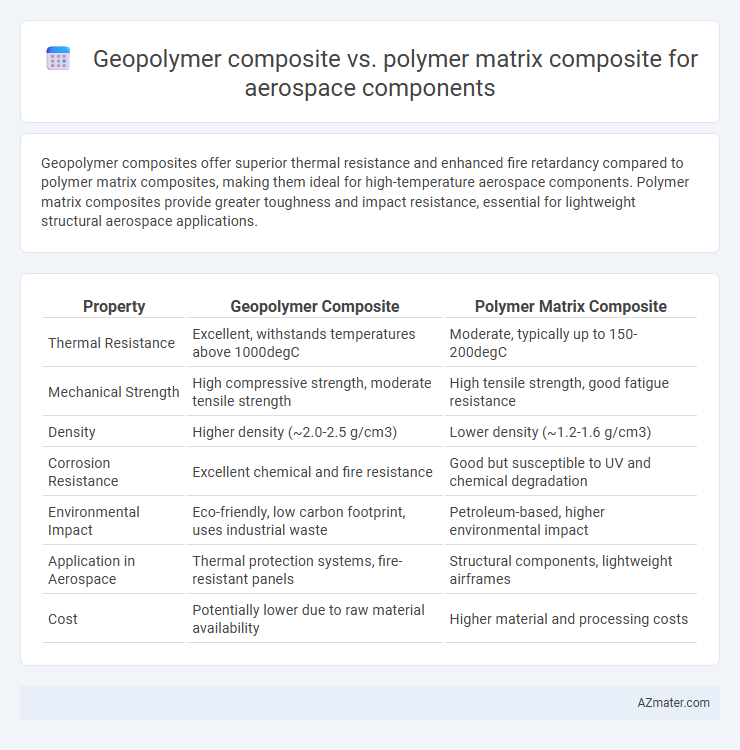Geopolymer composites offer superior thermal resistance and enhanced fire retardancy compared to polymer matrix composites, making them ideal for high-temperature aerospace components. Polymer matrix composites provide greater toughness and impact resistance, essential for lightweight structural aerospace applications.
Table of Comparison
| Property | Geopolymer Composite | Polymer Matrix Composite |
|---|---|---|
| Thermal Resistance | Excellent, withstands temperatures above 1000degC | Moderate, typically up to 150-200degC |
| Mechanical Strength | High compressive strength, moderate tensile strength | High tensile strength, good fatigue resistance |
| Density | Higher density (~2.0-2.5 g/cm3) | Lower density (~1.2-1.6 g/cm3) |
| Corrosion Resistance | Excellent chemical and fire resistance | Good but susceptible to UV and chemical degradation |
| Environmental Impact | Eco-friendly, low carbon footprint, uses industrial waste | Petroleum-based, higher environmental impact |
| Application in Aerospace | Thermal protection systems, fire-resistant panels | Structural components, lightweight airframes |
| Cost | Potentially lower due to raw material availability | Higher material and processing costs |
Introduction to Advanced Composites in Aerospace
Geopolymer composites offer enhanced thermal stability and fire resistance compared to traditional polymer matrix composites, making them promising for aerospace components exposed to extreme temperatures. Polymer matrix composites, widely used in aerospace, provide high strength-to-weight ratios and excellent fatigue resistance essential for structural applications. Advances in geopolymer technology aim to overcome limitations in brittleness, positioning them as sustainable alternatives in next-generation aerospace materials.
Geopolymer Composites: Structure and Properties
Geopolymer composites exhibit a three-dimensional aluminosilicate network structure that provides exceptional thermal stability and fire resistance, making them suitable for aerospace applications requiring high-temperature performance. Their inorganic matrix offers superior chemical resistance and lower environmental impact compared to conventional polymer matrix composites, while maintaining competitive mechanical properties such as high compressive strength and dimensional stability. The inherent low density and ability to tailor geopolymer formulations enable lightweight aerospace components with enhanced durability and reduced maintenance costs.
Polymer Matrix Composites: Overview and Characteristics
Polymer Matrix Composites (PMCs) in aerospace applications consist of a polymer resin reinforced with fibers such as carbon, glass, or aramid, offering high strength-to-weight ratios and excellent fatigue resistance. These composites provide superior damage tolerance, thermal stability, and ease of processing compared to geopolymer composites, making them ideal for critical structural components in aircraft and spacecraft. PMCs also exhibit tailored mechanical properties through fiber orientation and matrix selection, enhancing performance under dynamic aerospace conditions.
Comparative Mechanical Performance
Geopolymer composites exhibit higher thermal stability and resistance to high-temperature oxidation compared to polymer matrix composites, making them suitable for aerospace applications requiring prolonged exposure to extreme heat. Polymer matrix composites generally demonstrate superior toughness and fatigue resistance, providing enhanced mechanical performance under cyclic loading conditions common in aerospace environments. The stiffness-to-weight ratio of polymer matrix composites is often higher, but geopolymers offer improved compressive strength, which can be advantageous for specific structural aerospace components.
Thermal Stability and Fire Resistance
Geopolymer composites exhibit superior thermal stability compared to polymer matrix composites, maintaining structural integrity at temperatures above 1000degC, while polymer composites typically degrade beyond 300degC. The inherent ceramic-like properties of geopolymers provide exceptional fire resistance, reducing flammability and smoke generation critical for aerospace safety standards. Polymer matrix composites often require additional flame retardants to meet fire resistance criteria, but their performance remains limited under extreme thermal conditions found in aerospace applications.
Weight and Density Considerations
Geopolymer composites exhibit significantly lower density compared to traditional polymer matrix composites, offering a substantial advantage in aerospace weight reduction. The reduced weight of geopolymer composites enhances fuel efficiency and payload capacity, critical parameters in aerospace applications. Additionally, their superior thermal stability at elevated temperatures makes geopolymer composites highly suitable for lightweight aerospace components requiring both low density and heat resistance.
Environmental Impact and Sustainability
Geopolymer composites exhibit significantly lower carbon footprints compared to polymer matrix composites due to their use of industrial byproducts like fly ash or slag, reducing reliance on petrochemical resins and minimizing greenhouse gas emissions. Their inherent fire resistance and low toxicity enhance sustainability by improving recyclability and reducing hazardous waste in aerospace applications. Polymer matrix composites, while offering high strength-to-weight ratios, often rely on non-renewable fossil-based polymers, posing greater environmental challenges in production, disposal, and lifecycle sustainability.
Manufacturing Processes and Scalability
Geopolymer composite manufacturing involves low-temperature curing and minimal energy consumption, offering sustainable scalability for aerospace components through easy moldability and rapid setting times. Polymer matrix composites (PMCs) require high-temperature curing and specialized autoclave processing, which limit large-scale production and increase manufacturing costs. Scalability favors geopolymer composites due to their simpler process, reduced environmental impact, and compatibility with additive manufacturing techniques in aerospace applications.
Cost Analysis and Economic Viability
Geopolymer composites offer significant cost advantages over polymer matrix composites (PMCs) in aerospace applications due to lower raw material expenses and reduced energy consumption during manufacturing. The economic viability of geopolymers is enhanced by their thermal stability and resistance to chemical degradation, which can reduce maintenance and replacement costs over the component's lifecycle. Despite PMCs providing higher strength-to-weight ratios, the cost-benefit analysis increasingly favors geopolymers, especially for non-structural or moderately loaded aerospace components where budget constraints are critical.
Future Trends and Aerospace Applications
Geopolymer composites are gaining traction in aerospace applications due to their superior thermal stability, flame resistance, and eco-friendly manufacturing processes compared to traditional polymer matrix composites (PMCs). Future trends indicate increasing integration of geopolymer composites in high-temperature aerospace components, such as thermal insulation panels and fire-resistant barriers, driven by their low carbon footprint and excellent mechanical properties. Advances in nanotechnology and hybrid composite formulations are expected to enhance the structural performance and sustainability of geopolymer composites, positioning them as viable alternatives to PMCs in next-generation aerospace designs.

Infographic: Geopolymer composite vs Polymer matrix composite for Aerospace component
 azmater.com
azmater.com